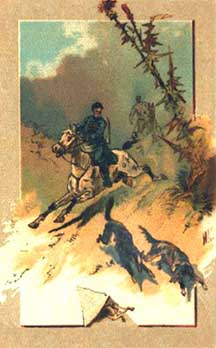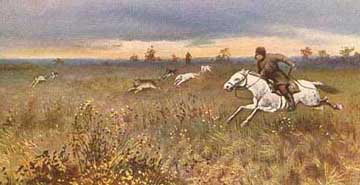|
With all his beauty and gentle, companionable ways, the Borzoi
is by instinct, breeding and character a coursing hound. In 19th
Century Russia, before dispersion of the estates, Borzoi were
kept by the aristocracy to hunt wolves. Following is Mr. Joseph
B. Thomas' description of the hunt he attended in 1903, during
his visit to Russia, with His Imperial Highness the Grand Duke
Nicholas:
The hunting preserves of the Grand Duke Nicholas extended
over two hundred thousand acres. The establishment of the Grand
Duke was laid out in 'the grand manner'; the ten individual stucco
kennels for the Borzoi, each with a grass court, flanked the
dip of a valley aligned with the magnificent hunting lodge of
Italian architec-ture. At the far end of the valley, the foxhound
kennels designed in keeping with the lodge completed the rectangle....
On his enormous estate of Perchina, the hare, the fox, and.the
wolf are preserved with the greatest care. The three hundred
Borzoi and hundred couple of foxhounds are kept in the most perfect
manner, trained and fitted for their work with the discipline
and individual attention practiced in a racing stable.... The
Grand Duke's Borzoi are exclusively the ancient type hounds.
There are two distinct methods of hunting: one, called field
hunting, where the huntsmen, mounted on ponies, proceed in a
long skirmish line across the open, fenceless country, slipping
their hounds on whatever jumps up. They advance at a walk or
slow trot, in a half-moon-shape skirmish line, about two hundred
yards apart. Another distinctly different method is that of stationing
on all sides of a covert mounted huntsmen with Borzoi in slips.
If wolves are likely to be found, two dogs and a bitch make 'the
team'. Hare and foxes are more often coursed than wolves; but
in each case three different methods are employed to drive the
game from covert. It must be understood that the country is quite
without fences or ditches, with only here and there small groves
of a few acres in extent. The whereabouts of game is usually
reported by the herdsman.
In the early morning may be seen wending its way along the
trail-like rounds of the district, a long line of mounted hunters,
each holding in his left hand a leash of three magnificent Borzoi,
two dogs and a bitch as nearly matched in color and conformation
as possible, and followed by the pack of Anglo-Russian foxhounds,
with the huntsmen and whips in red tunics. On arriving at the
scene of the chase, the hunters are stationed by the Master of
the Hunt at intervals of a hundred yards or so until the entire
grove is surrounded by a long cordon of hounds and riders.  A signal note is heard on a hunting
horn, and with the mingled music of the trail hounds, shouts
of men, and the cracking of whips, the foxhound pack is urged
into the grove in pursuit of hidden game. The scene is certainly
a medieval one. The hunters, dressed in typical Russian costumes,
with fur-trimmed hats, booted and spurred, and equipped with
hunting-horn, whip and dagger, and mounted on padded Cossack
saddles high above the backs of their Kirghiz ponies, holding
on straining leash their long-coated, exceedingly beautiful animals,
make a picture that once seen is not easily forgotten. A signal note is heard on a hunting
horn, and with the mingled music of the trail hounds, shouts
of men, and the cracking of whips, the foxhound pack is urged
into the grove in pursuit of hidden game. The scene is certainly
a medieval one. The hunters, dressed in typical Russian costumes,
with fur-trimmed hats, booted and spurred, and equipped with
hunting-horn, whip and dagger, and mounted on padded Cossack
saddles high above the backs of their Kirghiz ponies, holding
on straining leash their long-coated, exceedingly beautiful animals,
make a picture that once seen is not easily forgotten.
But hark! The sound of hound voices is changed to a sudden
sharp yapping of the pack in full cry, and simultaneously there
springs from the covert a dark grey form bent upon reaching the
next woods, some hundreds of yards away. In an instant he is
well in the open, and sees, only too late, that he has approached
within strik-ing distance of the nearest leash of Borzoi.  With a cry of 'Ou-la-lou', and
setting his horse at a gallop, the hunter slips his hounds when
they view the game, to sight which they oftentimes jump five
or six feet in the air. There is a rush,-a spring,-and with a
yelp the foremost hound is sent rolling; but instantly is back
to the attack, which continues-a confused mass of white and grey,
swiftly leaping forms and snapping fangs-until a neck-hold is
secured by the pursuing Borzoi, who do their best to hold the
wolf prostrate. Then, in a most spirited dash, the hunter literally
throws himself from the saddle of his hunting pony onto the prostrate
wolf. Formerly, a deftly wielded knife assisted in avoiding any
further trouble for the dogs; but of late years it has become
better form to take the wolf alive. A short stick with a thong
at each end, being held in front of the wolf, he seizes it, and
the hunter with instant dexterity, ties the thong behind the
brutes neck. Reynard and the hare are captured in the same manner
by the dogs, but in that case a toss in the air is usually sufficient. With a cry of 'Ou-la-lou', and
setting his horse at a gallop, the hunter slips his hounds when
they view the game, to sight which they oftentimes jump five
or six feet in the air. There is a rush,-a spring,-and with a
yelp the foremost hound is sent rolling; but instantly is back
to the attack, which continues-a confused mass of white and grey,
swiftly leaping forms and snapping fangs-until a neck-hold is
secured by the pursuing Borzoi, who do their best to hold the
wolf prostrate. Then, in a most spirited dash, the hunter literally
throws himself from the saddle of his hunting pony onto the prostrate
wolf. Formerly, a deftly wielded knife assisted in avoiding any
further trouble for the dogs; but of late years it has become
better form to take the wolf alive. A short stick with a thong
at each end, being held in front of the wolf, he seizes it, and
the hunter with instant dexterity, ties the thong behind the
brutes neck. Reynard and the hare are captured in the same manner
by the dogs, but in that case a toss in the air is usually sufficient.
In a few places around the globe, Borzoi are still used as
working hunters, and continue the breed's traditional role as
capturers of large predatory game such as the African hyena.
Similarly, there still can be found in some of the more remote
regions of the U.S. a few Borzoi whose work is to combat the
wolf and coyote marauders of cattle and sheep. But these are
the exceptions in the modern world. The vast majority of Borzoi
are kept as companions, pets, family protectors, show animals,
or occasionally for individual sport hunting.
Text from the "The Borzoi". Blue book published
by Borzoi Club of America in 1973. |